Wilderness Survival Himalayas: Unleashing Your Inner Forager
Indian Himalayas
Are you an intrepid explorer venturing into the awe-inspiring Himalayas? Picture this: you’re hiking, trekking, or climbing through the breathtaking mountain range when, unexpectedly, you find yourself lost. Fear not! Equipping yourself with knowledge of the Himalayas’ edible plants can be the key to wilderness survival skills. In this comprehensive guide, we will delve into ten remarkable plants found in the Himalayas, their local names, descriptions, where to find them, preferred altitudes, regions of occurrence, and essential precautions. Get ready for an engaging adventure filled with fascinating facts that will keep you enthralled from start to finish!
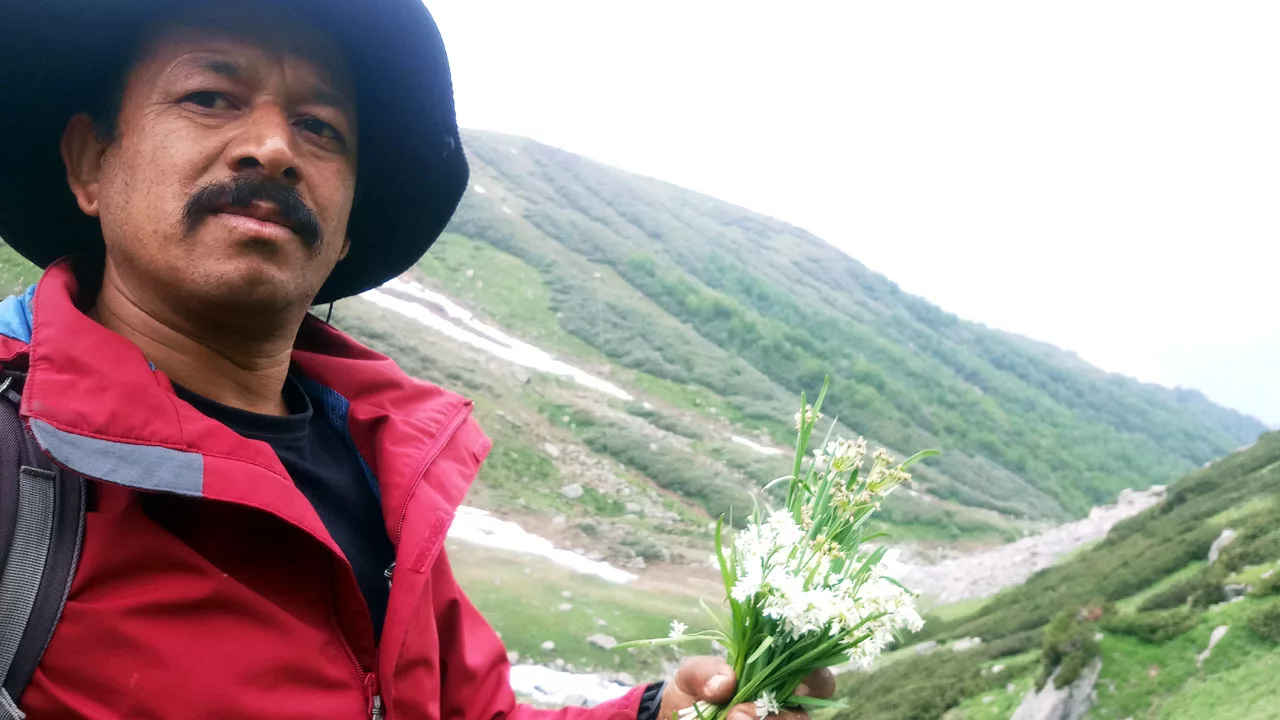
What is Foraging in Wilderness Survival?
Foraging in wilderness survival refers to the act of searching for and gathering wild food resources from the natural environment to sustain oneself during a survival situation. It involves identifying and harvesting edible plants, fungi, insects, and other sources of nourishment found in the wild. Foraging is a crucial skill in wilderness survival as it provides sustenance when traditional food sources are scarce or unavailable. It requires knowledge of local flora and fauna, an understanding of edible and poisonous species, and proficiency in harvesting and preparing wild foods. Foraging not only provides vital nutrition but also connects individuals to the natural world, fostering self-sufficiency and resilience in challenging outdoor scenarios.
Alpine Strawberry (Fragaria Vesca)
- Local Name: Chhota Toot / Bhoomphal
- Location: Alpine meadows and rocky areas.
- Altitude: Found at various altitudes across the Himalayan region.
- Regions: Widely distributed throughout the Himalayas.
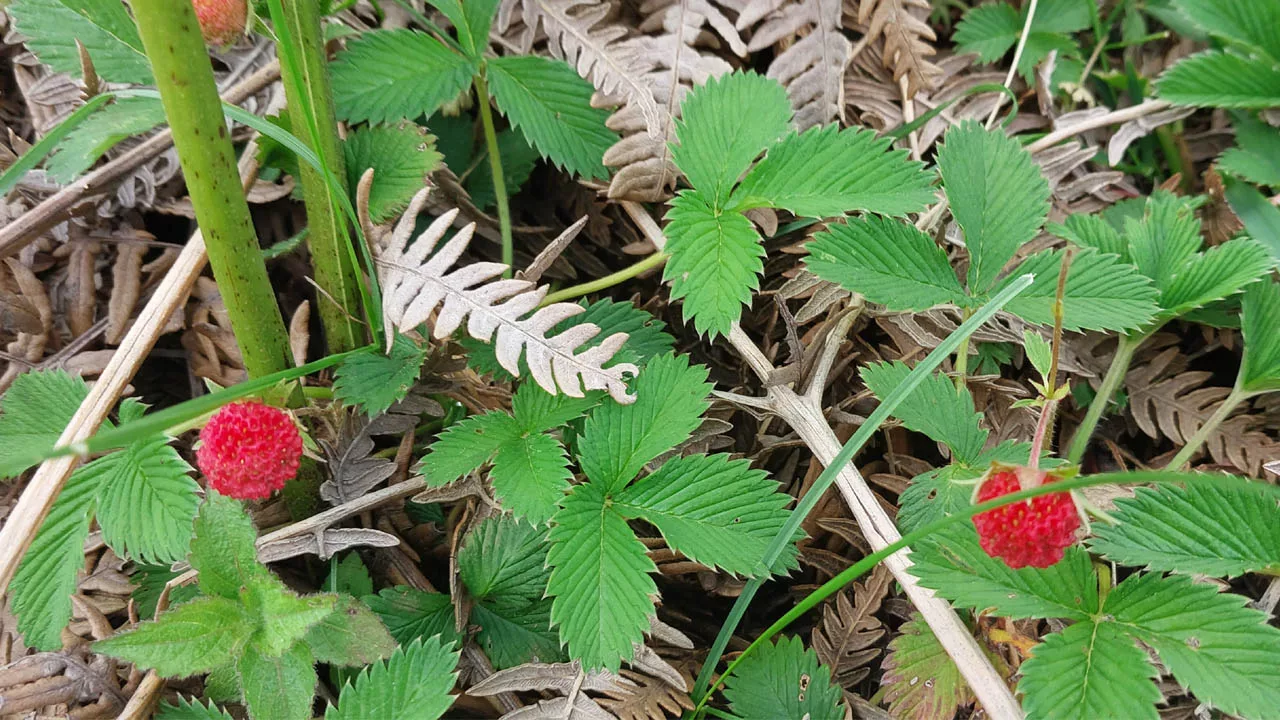
Description: Behold the delightful Alpine strawberry, also known as Chhota Toot, offering a burst of sweetness amidst nature’s beauty. Discover these vibrant red berries in alpine meadows and rocky areas, adding a touch of joy to your survival journey.
Interesting Fact: Did you know that Alpine strawberries are renowned for their intense flavor and aroma, surpassing their cultivated counterparts? Prepare to be amazed as you indulge in these wild treasures!
Precautions: While Alpine strawberries are generally safe to consume, be cautious of toxic look-alike berries in the region. Ensure proper identification and avoid consuming any unknown or potentially harmful berries.
Morel Mushroom (Morchella)
- Local Name: Gucchi
- Location: Forests and grassy areas.
- Altitude: Generally found in lower to mid-altitude regions.
- Regions: Widely distributed across the Himalayas.
Description: Prepare to be enchanted by Gucchi, the captivating Morel mushroom (edible Sac Fungi) found in the Himalayas. With its distinctive honeycomb-like cap, this gourmet delight thrives in forests and grassy areas, transforming your survival experience into a gastronomic adventure.
Interesting Fact: Renowned chefs worldwide hold Morel mushrooms in high regard for their earthy, nutty flavor. Discovering these edible gems in the wild is akin to unearthing nature’s hidden culinary masterpiece!
Precautions: Ensure thorough cooking of Morel mushrooms to avoid any potential digestive issues. If unsure about the mushroom’s identification, refrain from consuming it.
Stinging Nettle (Urtica Dioica)
- Local Name: Sisno / Bicchu Buti
- Location: Forested areas and riverbanks.
- Altitude: Found across a wide range of altitudes in the Himalayas.
- Regions: Commonly found throughout the Himalayan region.
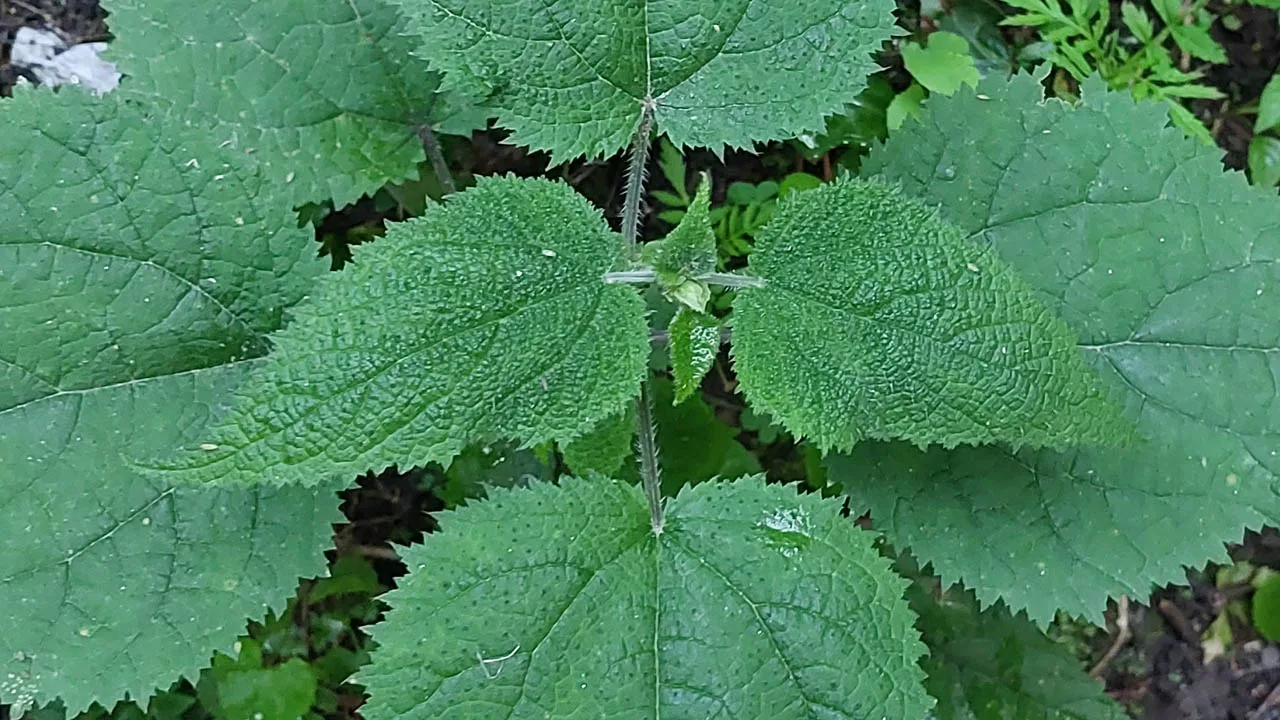
Description: Sisno, or the Stinging nettle, may give you a momentary pause with its tiny stinging hairs. However, fear not! Once properly handled and cooked, its young leaves turn into a flavorful tea or a delectable addition to various dishes.
Interesting Fact: Despite its prickly reputation, Stinging Nettle/Bicchu Buti has been cherished for centuries as a medicinal herb. Uncover its potential anti-inflammatory and diuretic properties, a testament to nature’s remarkable healing powers.
Precautions: Wear gloves and use caution while handling stinging nettle to avoid stings from its tiny hairs. Properly cook or steep the leaves to neutralize the sting before consumption.
Buckwheat (Fagopyrum Esculentum Moench)
- Local Name: Phapar
- Location: Cultivated in terraced fields and open areas.
- Altitude: Found at various altitudes in the Himalayas, depending on cultivation practices.
- Regions: Cultivated in parts of the Indian Himalayas, such as Uttarakhand and Himachal Pradesh.
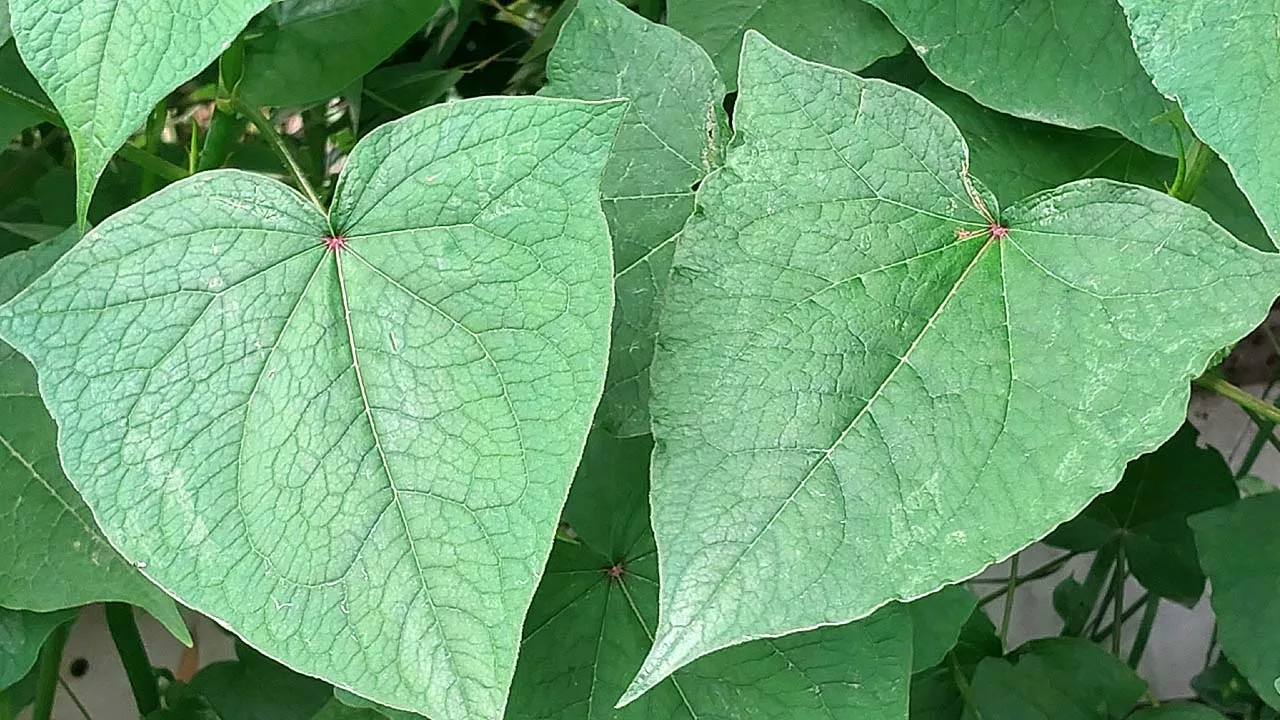
Description: Buckwheat is a pseudocereal crop that is widely grown in the Himalayan region. It has triangular seeds that are commonly used as a grain substitute in various dishes. Buckwheat is rich in dietary fiber, essential minerals, and antioxidants. It has a nutty flavor and is often ground into flour to make pancakes, noodles, or bread.
Interesting Fact: Despite its name, buckwheat is not related to wheat and is gluten-free. It is an important staple in the mountainous regions of the Himalayas and is highly valued for its nutritional properties.
Precautions: While buckwheat is generally safe for consumption, individuals with specific dietary restrictions or allergies should exercise caution.
Fiddlehead Fern (Diplazium Esculentum)
- Local Name: Lingri/Lingru (In Nepal)
- Location: Damp and shaded areas, especially near streams and forest floors.
- Altitude: Found in lower to mid-altitude regions of the Himalayas.
- Regions: Widespread across the Himalayan region.
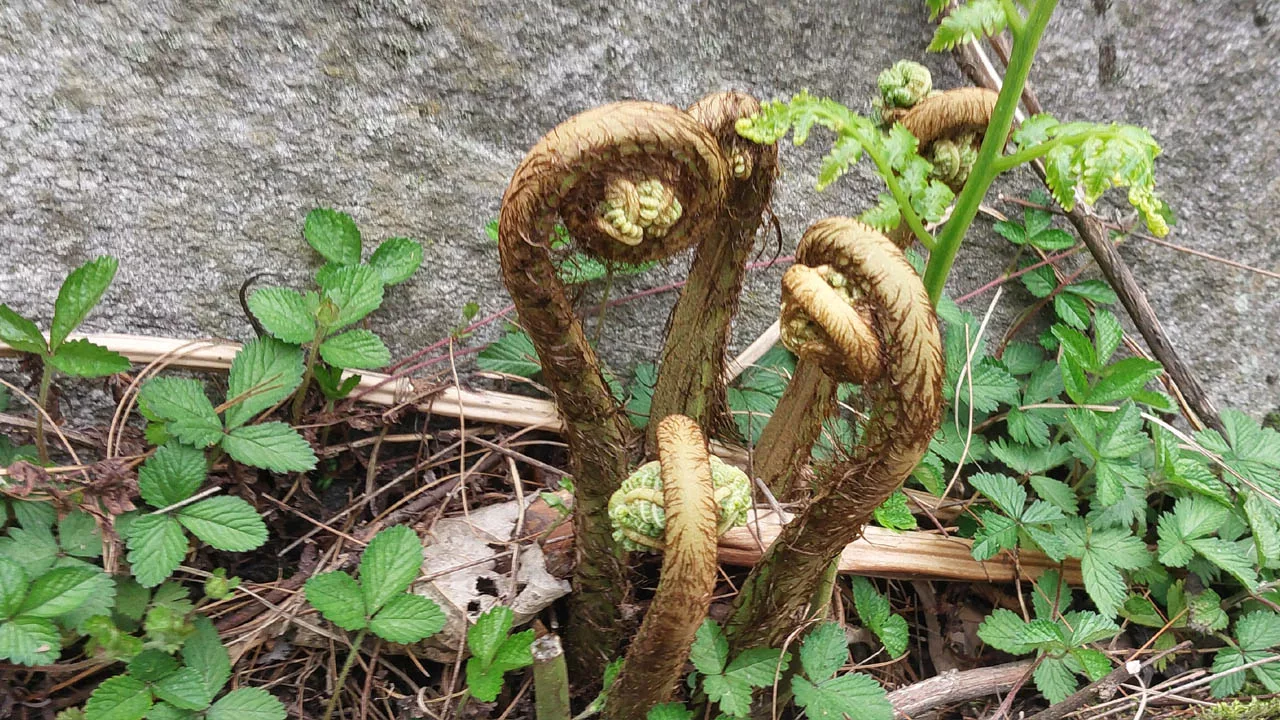
Description: Fiddlehead ferns are the young, tightly coiled fronds of certain fern species. They are known for their distinct appearance, resembling the curled head of a fiddle or violin. Fiddleheads are considered a delicacy and are harvested for their unique taste and texture. They have a slightly nutty and earthy flavor, similar to asparagus. Fiddleheads are commonly blanched, sautéed, or used in stir-fries and soups.
Interesting Fact: Fiddlehead ferns are highly nutritious and are a good source of vitamins A and C, as well as antioxidants. They are enjoyed in many cuisines around the world and are particularly popular in Himalayan and Asian cooking.
Precautions: When harvesting fiddlehead ferns, ensure that you are collecting the correct species, as some ferns may resemble fiddleheads but are not suitable for consumption. Proper identification is essential to avoid potential toxicity. Additionally, it is recommended to cook fiddleheads thoroughly before consumption to eliminate any potential toxins or contaminants.
Himalayan Rhubarb (Rheum Australe)
- Local Name: Revand Chini
- Location: Alpine meadows, rocky slopes, and open grasslands in the Himalayas.
- Altitude: Found at higher altitudes in the Himalayas.
- Regions: Commonly found in the alpine regions of the Himalayas.
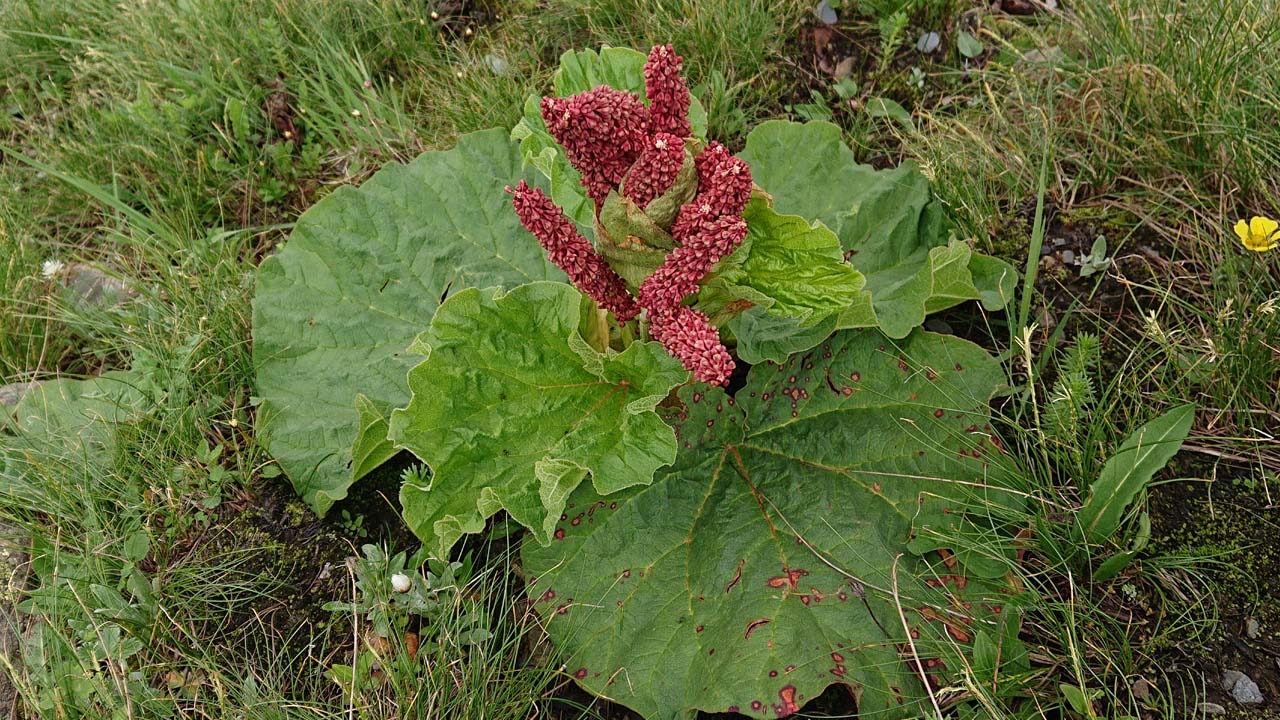
Description: Rheum Australe, also known as Himalayan Rhubarb, is a perennial herbaceous plant with large, fleshy leaves and a thick, edible stalk. The stalks of Himalayan Rhubarb are tart and acidic, similar to common rhubarb, and are often used in culinary preparations. The plant is known for its medicinal properties and is used in traditional medicine for digestive ailments.
Interesting Fact: Himalayan Rhubarb is valued not only for its culinary use but also for its dyeing properties. The roots of the plant yield a natural dye that produces shades of yellow and brown.
Precautions: Proper identification is crucial to differentiate Himalayan Rhubarb from other similar-looking plants. The leaves of Rheum Australe are toxic and should not be consumed. Harvest only the stalks, ensuring they are cooked thoroughly before consumption.
The Himalayan Onion (Allium Humile)
- Local Name: Dunu or Farn / Ban Lasun (In Nepali)
- Location: Alpine regions, rocky areas, and grassy slopes.
- Altitude: Found in higher altitude regions of the Himalayas.
- Regions: Widespread across the Himalayan range.
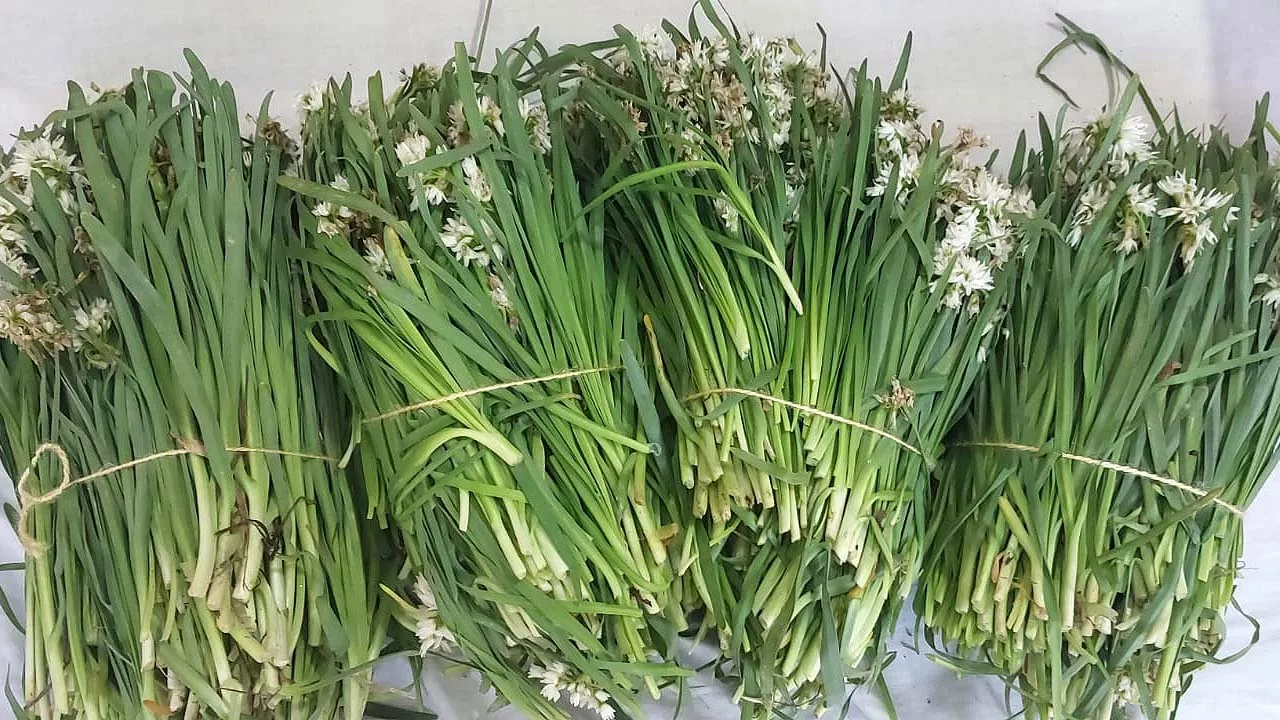
Description: Dunu or Farn or Himalayan Onion, adds a delightful onion-like flavor to the Himalayan forager’s palate. This wild relative of onion and garlic enhance the taste of various dishes, whether enjoyed raw or cooked.
Interesting Fact: Did you know that the pungent aroma of Himalayan Onion acts as a natural insect repellent? This makes it an ideal companion for outdoor adventures, keeping pesky bugs at bay. Embrace the multi-faceted qualities of this flavorful plant as you embark on your Himalayan exploration.
Precautions: Ensure proper identification to distinguish Himalayan Onion from other similar-looking plants. Harvest only the leaves and bulbs, using them raw or cooked as desired.
Rhododendron (Rhododendron Arboreum)
- Local Name: Burans / Buransh
- Location: Forested areas and slopes in the Himalayas.
- Altitude: Found in various altitudes depending on the species, ranging from lower to higher elevations.
- Regions: Commonly found throughout the Himalayan region.
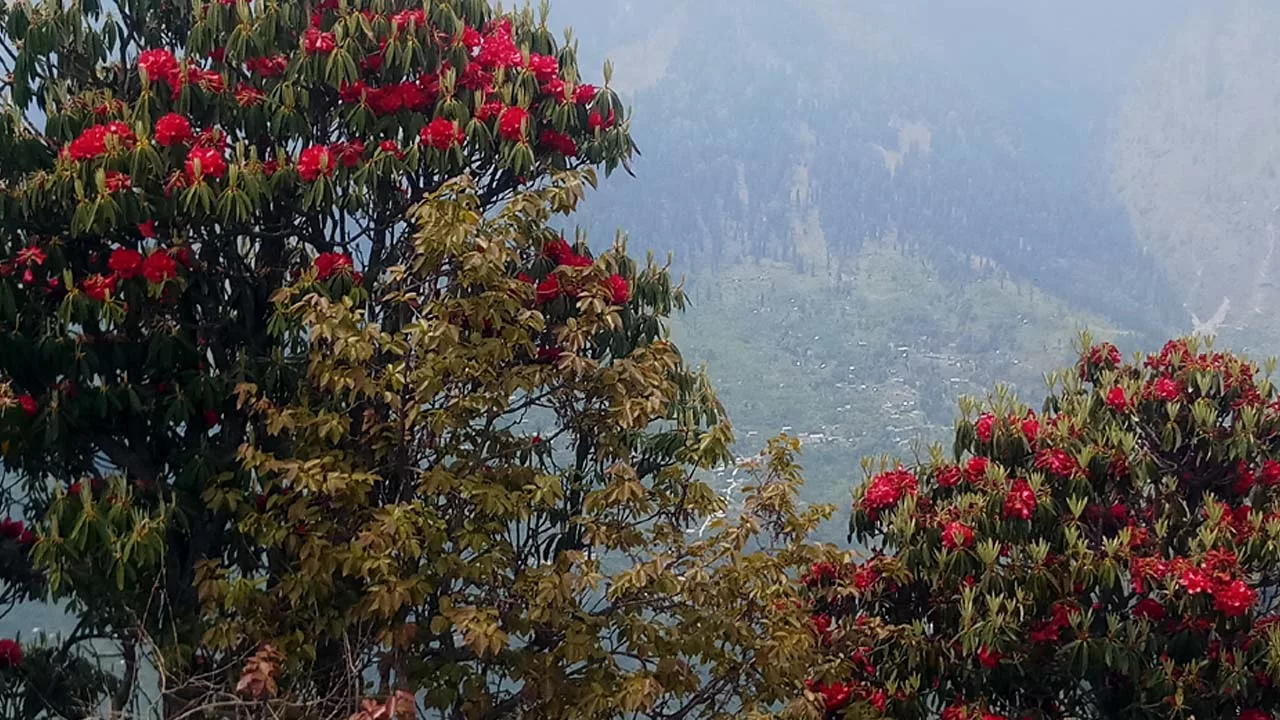
Description: Rhododendrons are beautiful flowering shrubs or trees that add vibrant colors to the Himalayan landscape. They have large clusters of showy flowers in hues of pink, red, purple, or white. While not all species of Rhododendron are edible, certain parts of some species can be consumed. The tender petals of some rhododendron flowers can be used to make refreshing and tangy drinks or infused into syrups.
Interesting Fact: Rhododendrons hold cultural significance in the Himalayas and are often used in local festivals and celebrations. The vibrant red flowers of the Rhododendron Arboreum species, in particular, are the state flower of Uttarakhand in India.
Precautions: It is important to note that not all species of Rhododendron are safe for consumption. Some species contain toxic compounds and should be avoided. Proper identification of the species is crucial before using any part of the plant for consumption. Consult with local experts or guides to ensure the safety and proper usage of Rhododendrons.
Juniper Berry (Juniperus Communis)
- Local Name: Aaraar/ Haubera/ Abhal (Unani)
- Location: Evergreen shrubs in various regions.
- Altitude: Found at different altitudes, depending on the specific species.
- Regions: Widely distributed throughout the Himalayas.

Description: Abhal, or Juniper berries, grace the evergreen shrubs of the Himalayas, infusing the air with their captivating aroma. Once dried and crushed, they lend a distinct flavor to a variety of dishes, enveloping them in a wilderness-infused charm.
Interesting Fact: Juniper berries carry a rich cultural heritage, often entwined with traditional medicine and folklore. Unravel the intriguing tales and medicinal applications linked to these remarkable little berries, adding an extra layer of enchantment to your Himalayan escapade.
Precautions: Properly identify juniper berries and ensure moderation in consumption. Avoid excessive harvesting to allow the plants to regenerate.
Cauliflower Mushroom (Sparassis Crispa):
- Local Name: Bhandlu (In Kullu)
- Location: Commonly found in coniferous forests, particularly in the Himalayan region.
- Altitude: Various altitudes in the Himalayas, typically in the lower to mid-altitude regions.
- Regions: Found throughout the Himalayan range.
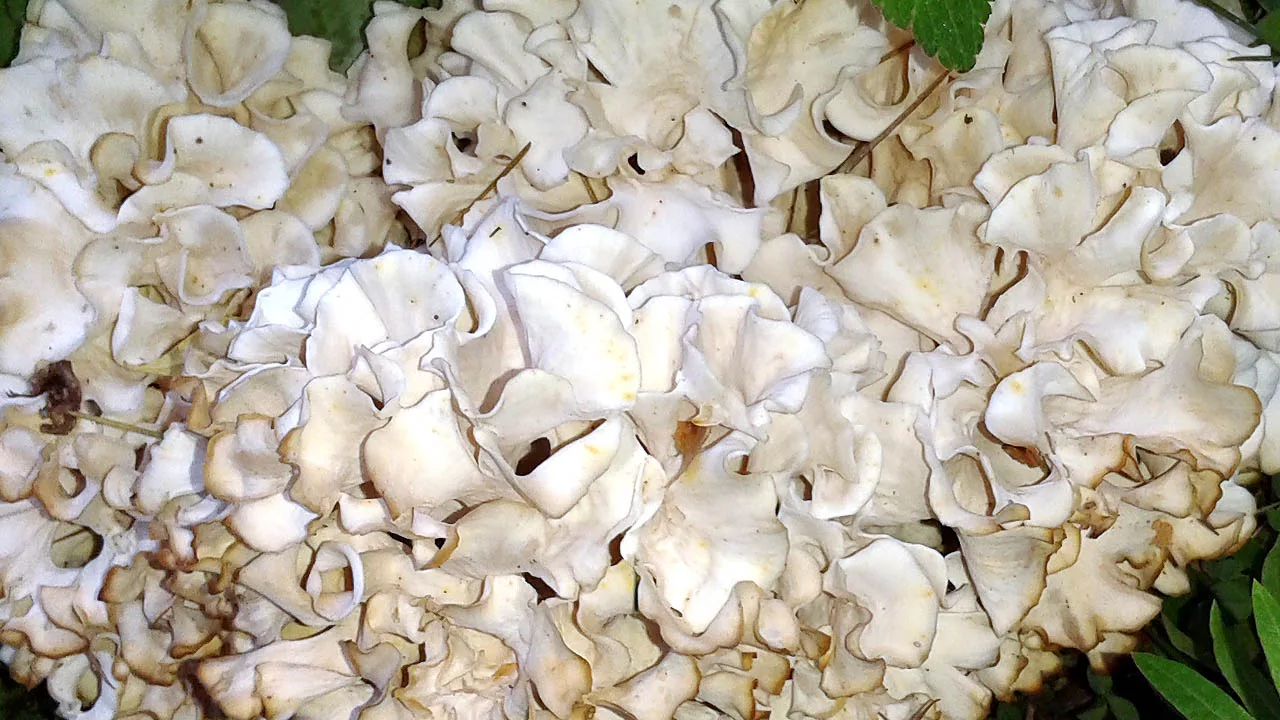
Description: Sparassis Crispa, also known as the cauliflower mushroom or fungus, is a unique and striking edible fungus. It has a distinctive appearance, resembling a cauliflower with its ruffled and convoluted branches. The color can range from pale to dark brown. This mushroom is prized for its delicate flavor and tender texture, making it a sought-after ingredient in culinary dishes.
Interesting Fact: Sparassis Crispa is a parasitic mushroom that grows on the roots of various tree species, particularly conifers. It forms a mutually beneficial relationship with its host, deriving nutrients while protecting the host from certain pathogens.
Precautions: When foraging for Sparassis Crispa, it’s important to properly identify the mushroom to avoid any potential look-alike species. Always exercise caution when consuming wild mushrooms and seek guidance from local experts or experienced foragers. Ensure proper cooking to fully enjoy its unique flavor and eliminate any potential toxins.
Not to Consume during Wilderness Survival Situation
During a wilderness survival situation, it is crucial to exercise caution and avoid consuming any plants or mushrooms that you are not certain are safe for consumption. While foraging for food can be a valuable skill, it is equally important to recognize the potential dangers of misidentification.

Certain plants and mushrooms in the wild can be toxic or even lethal if ingested. To stay safe, avoid consuming any plants or mushrooms with unknown identities or ones that you cannot positively identify as safe. It is advisable to rely on your knowledge of edible plants and mushrooms that you have previously researched and are familiar with. Additionally, be cautious of consuming any plants or mushrooms that exhibit signs of decay, have an unpleasant odor, or show visible signs of contamination. When in doubt, err on the side of caution and prioritize your safety by avoiding consumption.
Straw-Colored Fiber Head (Inocybe Rimosa)- Poisonous
- Local Name: Fibrous Head
- Location: Found in forests and grassy areas.
- Altitude: Typically found in mid to high-altitude regions.
- Regions: Commonly found in the Himalayan region.
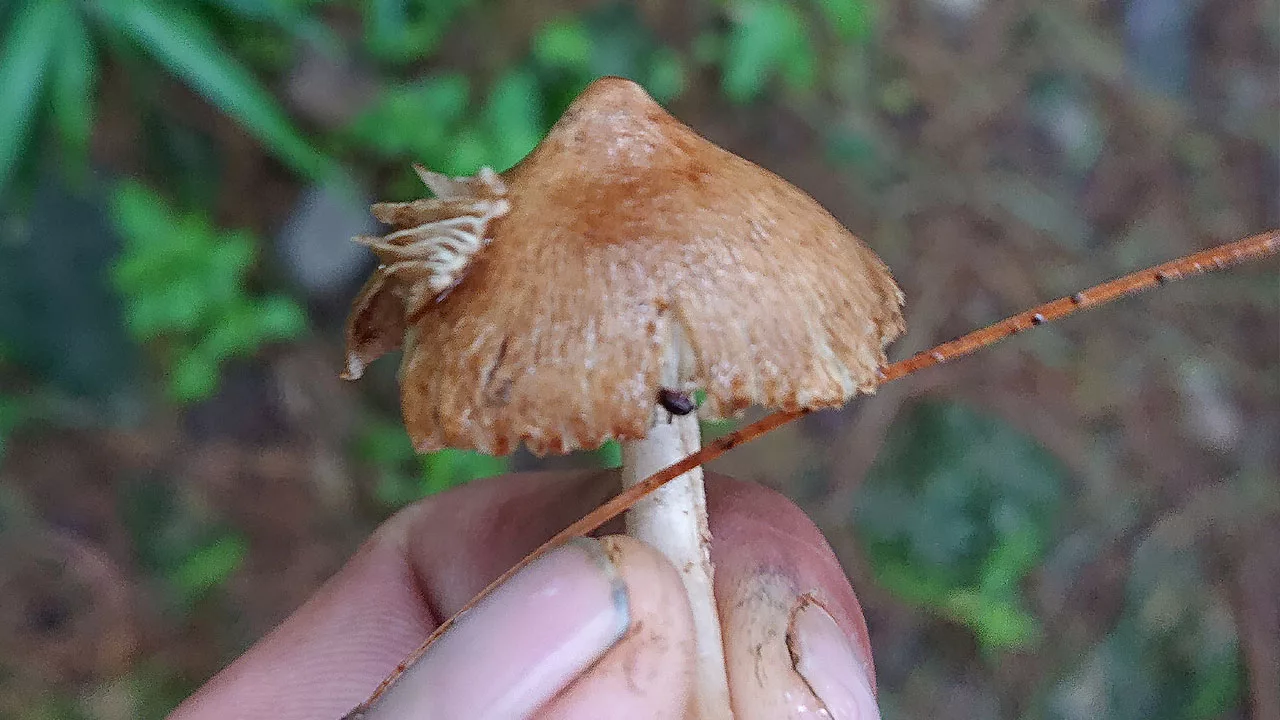
Description: Inocybe Rimosa is a species of mushroom that belongs to the Inocybe genus. It has a distinctive appearance with a convex or bell-shaped cap, which can vary in color from brown to reddish-brown. The gills on the underside of the cap are closely spaced and can have a whitish to pale brown color. The stem is often long and slender, with a whitish to grayish color. It is an ectomycorrhizal fungus, that forms a mutualistic association with the roots of trees.
Interesting Fact: Inocybe Rimosa or Straw-Colored Fiber Head is known for its unique spore dispersal mechanism. When the mushroom is mature and ready to release its spores, the cap margin curls inward, covering the gills. As the cap expands, the pressure builds up, and when the margin suddenly unfurls, it releases a cloud of spores.
Precautions: Inocybe Rimosa and other species within the Inocybe genus are known to contain potentially toxic compounds. It is crucial to exercise caution when foraging mushrooms and to have proper identification skills. Unless you have expert knowledge in mycology and can confidently identify Inocybe Rimosa, it is recommended to avoid consumption to prevent any adverse effects.
Note: It is important to remember that foraging wild mushrooms can be dangerous if you are not experienced and knowledgeable. Incorrect identification of mushrooms can lead to severe illness or even be life-threatening. Always consult with local experts or mycologists before consuming any wild mushrooms and follow proper precautions to ensure your safety.
Leopard Plant (Ligularia Amplexicaulis) – Anti-Poison
- Local Name: Ligularia/ Bistort
- Location: Moist areas, near streams, and in shady places.
- Altitude: Found at moderate to high altitudes in the Himalayas.
- Regions: Commonly found in regions across the Himalayan range.

Description: Ligularia Amplexicaulis, commonly known as Bistort, is a herbaceous perennial plant. It has large, heart-shaped leaves that are deeply veined and grow in a rosette pattern. The plant produces tall flower spikes with bright yellow flowers. Bistort is valued for its ornamental beauty and is often found in moist areas, near streams, and in shady places in the Himalayas. It is best to avoid consuming it
Interesting Fact: Bistort has been traditionally used in herbal medicine for its medicinal properties. It is believed to have anti-inflammatory and astringent properties and has been used to treat digestive ailments and skin conditions.
Precautions: Ligularia Amplexicaulis or Stem Clasping Ligularia is a traditional anti-poison plant. If you are unsure about the identification or usage of Bistort, it is best to avoid consuming it.
Hemp (Cannabis Sativa) – Psychoactive
- Local Name: Bhang
- Location: Cultivated and wild varieties found in various regions.
- Altitude: Varies based on specific cultivation or growth.
- Regions: Cultivated in parts of the Indian Himalayas.

Description: Beyond its industrial uses, Hemp, known as Bhang, holds nutritional prowess in its seeds. Packed with protein, fiber, and essential fatty acids, it provides a valuable source of sustenance amidst the Himalayan wilderness. We suggest not consuming hemp during wilderness survival situations.
Interesting Fact: Delve into the ancient history of Hemp, a plant that has served humanity for millennia. From ropes and textiles to nourishing sustenance, this versatile plant weaves a captivating narrative that spans the ages.
Precautions: Differentiate between hemp and marijuana plants, as marijuana contains higher levels of the psychoactive compound THC.
Precautions for Foraging in the Himalayan Wilderness Survival:
To ensure your safety during foraging expeditions, remember these essential precautions:
- Proper identification is paramount to avoid consuming toxic plants. Consult reliable field guides specific to the Himalayan region or seek guidance from local experts.
- Harvest and consume plants in moderation, ensuring sustainability and preserving the delicate balance of nature.
- Familiarize yourself with potential look-alike plants, honing your skills to distinguish edible species accurately.
- Respect local regulations and any restrictions on foraging in protected areas, embracing the role of responsible stewards of the environment.
- Prioritize your safety, and if you find yourself lost in the Himalayas, seek professional help or guidance to navigate your way back to civilization.
Embark on a Journey of Wilderness Survival in the Himalayas:
As you venture into the breathtaking wilderness of the Himalayas, remember that survival lies not only in physical resilience but also in embracing the natural bounty surrounding you. Armed with the knowledge of these ten edible plants, their captivating facts, and the necessary precautions, you are primed to navigate the Himalayan landscape and unlock the wonders of survival foraging. Allow nature’s generous offerings to guide you on an unforgettable journey of self-discovery amidst the majesty of the Himalayas.